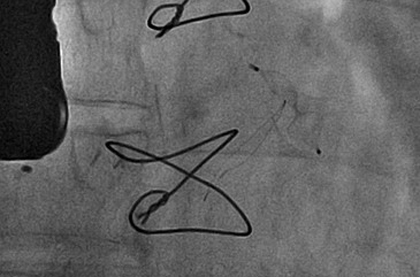
All centers in UK and Ireland performing percutaneous PVL closure delivered their data to the UK PVL registry. Data were analyzed for factors associated with mortality and major cardiovascular events at follow up.
There were 308 percutaneous PVL closure procedures in 259 patients between 2004 and 2015 in 20 centers. Population mean age was 67±13 years and 28% were women.
Main indication for percutaneous PVL closure was:
- Cardiac failure, 80% of cases.
- Hemolysis, 16% of cases.
Implantation was successful in 91% of patients via:
- Transradial (7%)
- Transfemoral arterial (52%)
- Transfemoral venous (33%)
- Transapical (7%)
19% of patients required reintervention.
Intervened valves were:
- Mitral, 44%
- Aortic, 48%.
- Both, 2%.
- Pulmonic, 0.4%.
- TAVR, 5%.
Periprocedural leak was severe in 61% and multiple in 37% of cases, and improved significantly after procedure (p<0.001), disappearing in 33.3%, or becoming mild (41.4%) or moderate residual leak (18.6%).
Patient functional class also improved significantly at median 110 day follow up.
In hospital death was:
- Elective cases, 2.9%.
- Urgent cases, 6.8%.
- Emergency procedures, 50%.
[plain]
At follow up, mortality resulted 16%, vascular surgery 6% and late device embolization 0.4%. The mitral valve was associated with more adverse events compared to the rest of the valves.
[/plain]
Factors independently associated with death were:
- Degree of persistent leak (HR 2.87; p=0.037).
- Functional class at follow up (HR 2.00; p=0.015).
- Baseline creatinine (HR 8.19; P=0.001).
Conclusion
Percutaneous paravalvular leak closure is effective and improves leak severity and symptom severity. Post procedural residual leak severity is independently associated with adverse events and death. Percutaneous PVL closure must be considered an alternative to repeat surgery.
Original Title: Percutaneous Device Closure of Paravalvular Leak. Combined Experience From the United Kingdom and Ireland.
Reference: Patrick A. Calvert et al. Circulation. 2016 Sep 27; 134(13):934-44.
Subscribe to our weekly newsletter
Get the latest scientific articles on interventional cardiology
We value your opinion. You are more than welcome to leave your comments, suggestions or questions here below.



